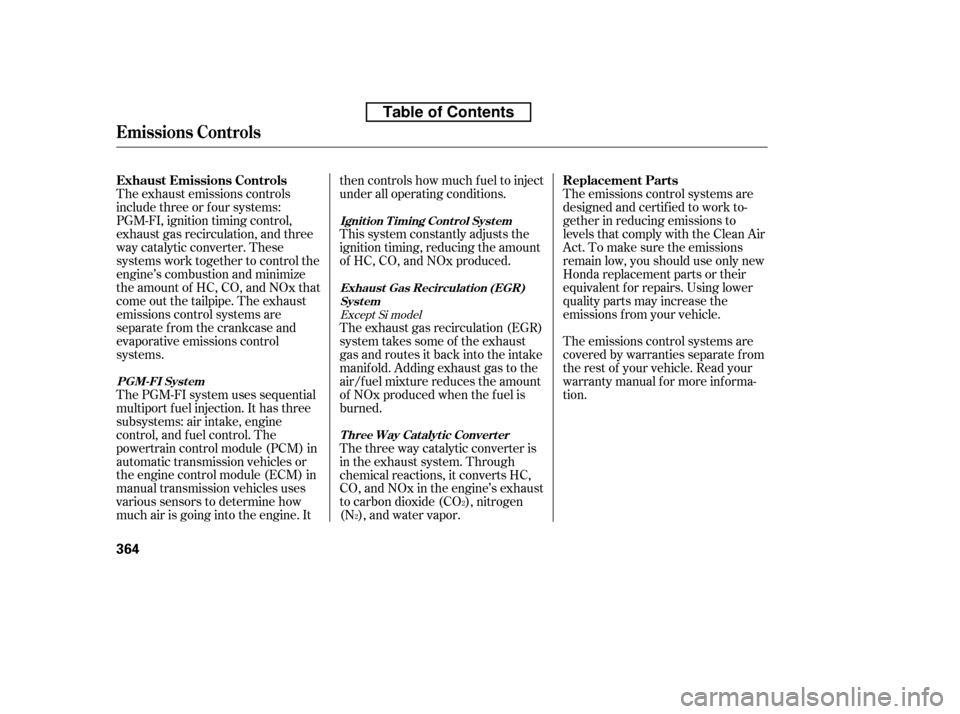Page 362 of 387

�µ�µ
If your vehicle needs to be towed,
call a prof essional towing service or
organization. Never tow your vehicle
with just a rope or chain. It is very
dangerous.
The operator
loads your vehicle on the back of a
truck.
Therearetwowaystotowyour
vehicle: If , due to damage, your vehicle must
be towed with the f ront wheels on
the ground, do this:
Release the parking brake.
Shif t the transmission to neutral.
Leave the ignition switch in the
ACCESSORY (I) position so the
steering wheel does not lock.
The tow
truck uses two pivoting arms that go
under the f ront tires and lif t them of f
the ground. The rear tires remain on
the ground. With the f ront wheels on the ground,
do not tow the vehicle more than 50
miles (80 km), and keep the speed
below35mph(55km/h).
Start the engine.
Press on the brake pedal. Move
the shif t lever through all its
positions.
Leave the ignition switch in the
ACCESSORY (I) position so the
steering wheel does not lock.
Release the parking brake.
Turn of f the engine.
Shif t to D position and hold f or 5
seconds, then to N.
Manual transmission:
Automatic transmission:
Flat -bed Equipment
Wheel-lif t Equipment
T his is the best way to
transport your vehicle.
This is an acceptable
way to tow your vehicle.
Emergency T owing
348
Improper towing preparation will
damage the transmission. Follow the
above procedure exactly. If you cannot
shif t the transmission or start the
engine (automatic transmission), your
vehicle must be transported with the
f ront wheels of f the ground.
Table of Contents
Page 363 of 387
Do not tie down the vehicle at an
angle that would allow the towing
cables to contact the vehicle’s f ront
bumper. To avoid possible damage,
protect the f ront bumper with tape.
If your vehicle is equipped with a
f ront spoiler, remove it bef ore
towing so it is not damaged.
Emergency T owing
T aking Care of t he Unexpect ed
349
The steering system can be damaged if
the steering wheel is locked. Leave the
ignition switch in the ACCESSORY (I)
position, and make sure the steering
wheel turns f reely bef ore you begin
towing.
Trying to lif t or tow your vehicle by the
bumpers will cause serious damage.
The bumpers are not designed to
support the vehicle’s weight.
Table of Contents
Page 364 of 387

�µ
Thediagramsinthissectiongive
you the dimensions and capacities of
your vehicle and the locations of the
identif ication numbers. It also
includes inf ormation you should
know about your vehicle’s tires and
emissions control systems.
................
Identif ication Numbers . 352
................................
Specif ications . 354
DOT Tire Quality Grading
......................
(U.S. Vehicles) . 357
.................................
Treadwear . 357
......................................
Traction . 357
.............................
Temperature . 358
.................................
Tire Labeling . 359
Tire Pressure Monitoring
System (TPMS) Required .............
Federal Explanation . 361 .......................
Emissions Controls . 363
.....................
The Clean Air Act . 363
Crankcase Emissions Control
....................................
System . 363
Evaporative Emissions Control ....................................
System . 363
Onboard Ref ueling Vapor ................................
Recovery . 363
...
Exhaust Emissions Controls . 364
....................
PGM-FI System . 364
Ignition Timing Control
................................
System . 364
Exhaust Gas Recirculation ...................
(EGR) System . 364
Three Way Catalytic ...........................
Converter . 364
....................
Replacement Parts . 364
..
Three Way Catalytic Converter . 365
........................
Emissions Testing . 366
T echnical Inf ormation
T echnical Inf ormation
351
Page 377 of 387

The emissions control systems are
designed and certif ied to work to-
gether in reducing emissions to
levels that comply with the Clean Air
Act. To make sure the emissions
remain low, you should use only new
Honda replacement parts or their
equivalent f or repairs. Using lower
qualitypartsmayincreasethe
emissions f rom your vehicle.
The emissions control systems are
covered by warranties separate f rom
the rest of your vehicle. Read your
warranty manual f or more inf orma-
tion.
The PGM-FI system uses sequential
multiport f uel injection. It has three
subsystems: air intake, engine
control, and f uel control. The
powertrain control module (PCM) in
automatic transmission vehicles or
the engine control module (ECM) in
manual transmission vehicles uses
various sensors to determine how
much air is going into the engine. It then controls how much f uel to inject
under all operating conditions.
This system constantly adjusts the
ignition timing, reducing the amount
of HC, CO, and NOx produced.
The exhaust emissions controls
includethreeorfoursystems:
PGM-FI, ignition timing control,
exhaust gas recirculation, and three
way catalytic converter. These
systems work together to control the
engine’s combustion and minimize
the amount of HC, CO, and NOx that
come out the tailpipe. The exhaust
emissions control systems are
separate f rom the crankcase and
evaporative emissions control
systems.
The three way catalytic converter is
in the exhaust system. Through
chemical reactions, it converts HC,
CO, and NOx in the engine’s exhaust
to carbon dioxide (CO ), nitrogen
(N ), and water vapor.
The exhaust gas recirculation (EGR)
system takes some of the exhaust
gas and routes it back into the intake
manif old. Adding exhaust gas to the
air/f uel mixture reduces the amount
of NOx produced when the f uel is
burned.
2
2
Except Si model
Exhaust Emissions Controls Replacement Parts
PGM-FI Syst emIgnit ion T iming Cont rol Syst em
Exhaust Gas Recirculat ion (EGR)Syst em
Three Way Catalytic Converter
Emissions Cont rols
364
Table of Contents